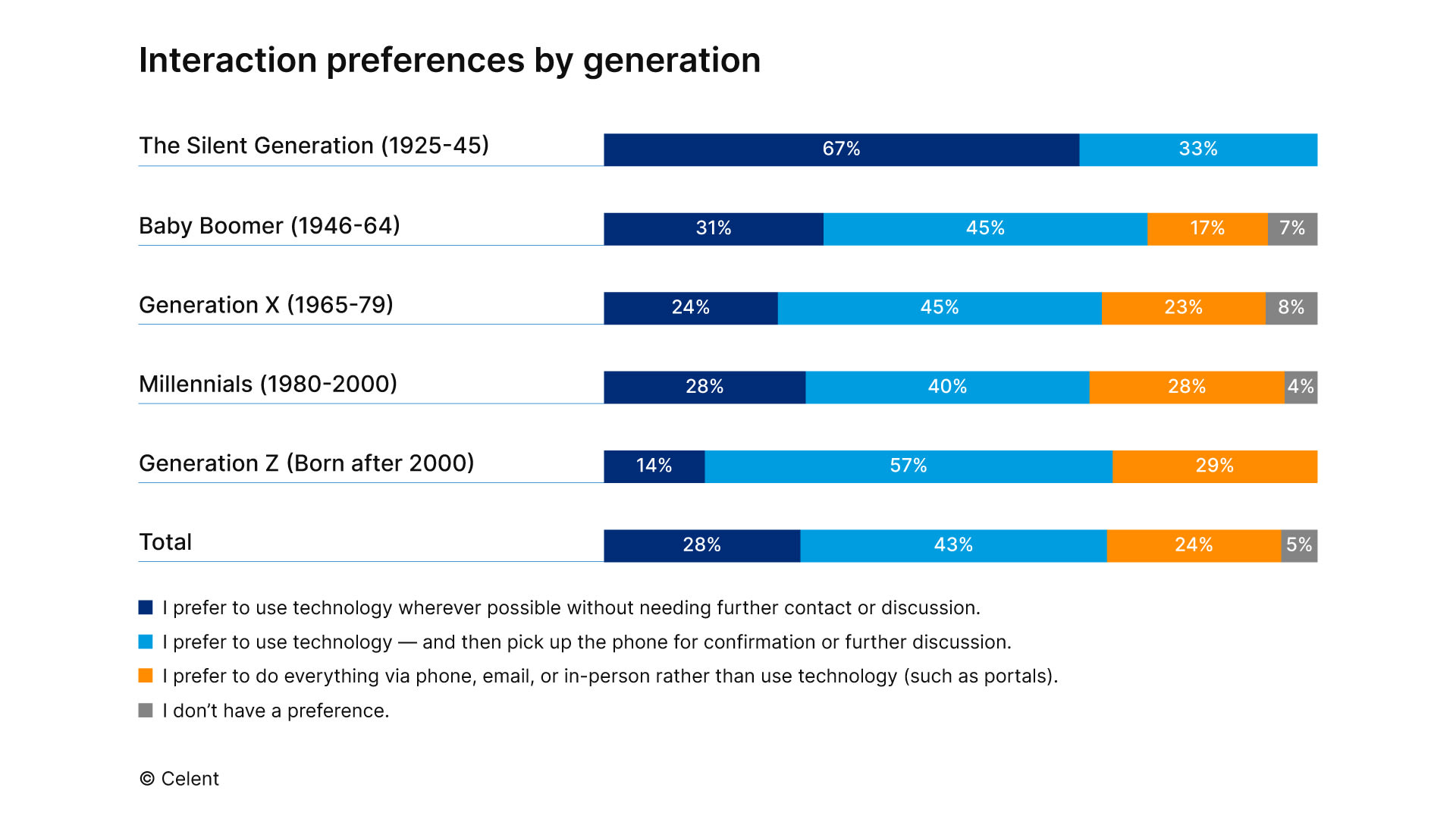Adapting to generational shifts: Meeting the changing needs of insurance agents
As the older generation retires, agents’ needs — and preferences — are changing. Celent’s Karlyn Carnahan explores how insurers can adapt.
As the older generation retires, agents’ needs — and preferences — are changing. Celent’s Karlyn Carnahan explores how insurers can adapt.

Are you seeing more calls from insurance agents to your call centers and underwriters? If you’re like most insurers, those calls have skyrocketed in the last few years.
There are a few reasons why.
We’ve seen a generational shift happening in the world of insurance agencies. The Department of Labor shows the average age of insurance agents dropping over the last five years as the older generation retires and is replaced with younger, entry-level employees.
These employees are new to insurance and want to provide excellent customer service and avoid errors and omissions exposures. But many agents have reduced their training programs. Others have gone to work-from-home or hybrid models, which reduce the ability for newer employees to connect with and learn from more experienced staff.
As the insurance industry moves inexorably down a digital path, technology is increasingly important to agents. But not all agents use technology the same way — or have the same desire to use technology.
We conducted a study asking agents how they prefer to interact with their insurer — technology only, phone/email only or a hybrid approach, and we cut it by age. What we found was rather surprising, and countered the prevailing opinion that younger generations prefer to use technology more than the older generations.
Surprisingly, it was the youngest generation that most wanted to pick up the phone and talk to someone. Almost 30% of Generation Z respondents said they prefer to do everything via phone, email or in person rather than use technology (such as portals) — the highest percentage across generations.

The Silent Generation and Baby Boomers were more likely to prefer to use technology than the younger generations. It may be that while the younger generations are quite familiar with technology, they are less familiar with insurance and want additional guidance and advice from experts at the insurer to ensure they are providing appropriate levels of protection.
This holds true across all roles and sizes of business. While approximately 25–30% of agents today prefer to work completely digitally, there is still a large demand for the personal touch. But delivering a personal touch is expensive. It’s always less costly to have the system handle routine tasks than to have a human do the same thing. And the ability to process work consistently reduces the noise and bias in the handling of transactions, which improves financial results.
Given the large number of agents that either want to do business entirely via phone, email or in person, or to use technology but then pick up the phone, insurers need to be certain their operations are tuned for in-person/phone conversations. So, what can an insurer do to help these early career agents while managing their own costs?
> Additional insights | A policy-holder first approach to the insurance experience
Insurers can move down several paths to use technology more effectively.
This reduces the number of questions an agent needs to answer — and may improve the accuracy of that data. If the agent doesn’t need to answer a question, then they don’t need to pick up the phone to understand the question in more detail.
For example, asking an agent to enter the construction class is problematic. While frame is relatively easy to identify, it’s a little more difficult to determine the difference between fire resistive and non-combustible. That data is relatively easy to obtain and can avoid either inaccurate data being entered or a phone call to ask for guidance.
Many insurers have hover over help on their portal. But most of the time, that help text focuses on how to fill in the field — e.g., the format of the data — rather than the reason why the information is needed. Adding more educational support helps the agents understand how the data is used, which can improve the quality of the information provided.
With the level of turnover occurring in the industry, there are a lot of new entrants that need additional support. Principals prefer training that is limited to their own agency. They are concerned that when they send good people to open training, other agencies poach their best people. In-person training is most desirable, according to our research. Gamification techniques may help these generations learn in a more engaging manner.
For example, calculators to ensure the agent is providing the right level of insurance to value. Another example: class code finders.
When planning the content available for your agents — manuals, help text, brochures and other agent support — shift to an intelligent content strategy that structures content as components that can be mixed and matched, delivering the exact content the user needs when they need it. This personalized approach makes it easier for the agent to quickly get to the information they need. When they can get the information quickly, they’re less likely to need to pick up the phone.
> Additional insights | The three keys to insurance innovation
This can prompt an agent to cross-sell additional coverages or determine what kinds of terms and conditions to request. It could be as simple as looking up information from a table or querying the book of business to provide a “People like you” recommendation (e.g., “Restauranteurs in Florida typically choose a $20,000 med pay limit”).
We’re starting to see insurers and vendors creating more complex tools using generative AI that allow agents to ask questions and get responses from the technology. Today, these tend to be relatively simple, such as using generative AI to query a manual. Insurers rightfully have concerns about how well trained the gen AI agent is and how well they’ve controlled hallucinations. But gen AI holds the promise for a better user experience for the agents.
> Additional insights | How agentic AI can transform insurance
Independent agents going through their own digital transformations are increasingly demanding new capabilities from insurers. They have high expectations for how insurers will support them today and have even higher expectations for how insurers will support them tomorrow.
There is a growing difference in need and attitude based on generational shifts. As the agency community continues to retire, new capabilities will be needed, both to enable a new generation that needs training and to appeal to a new generation of executives.
One last point: It’s not just the agents who have different generational communication preferences. Employees and customers also are looking for new ways of getting the right information quickly. As you build out new capabilities, keep a broad audience in mind and consider where reuse will be beneficial.
Karlyn Carnahan is the Head of The Americas Property Casualty practice for Celent. She is a widely recognized expert in the industry who has been extensively published in a broad range of industry media and general business media. She focuses on issues related to digital transformation and customer experience. Karlyn is the lead analyst for questions related to distribution management, underwriting and claims, core systems and operational excellence. She is a widely recognized expert on these topics who has written market-leading reports and presented at numerous conferences.

This checklist can be a valuable guide to selecting the right intelligent content solutions provider for your organization.

Considering a technology upgrade? This legacy assessment provides answers.

Explore the factors that make an organization in the insurance industry resilient and agile.